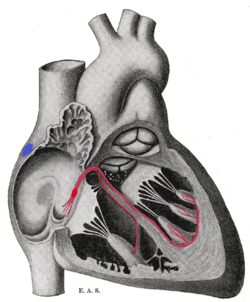This articleneeds morereliable medical referencesforverificationor relies too heavily onprimary sources.(July 2014) |  |
Thebundle of His(BH)[1]: 58 orHis bundle(HB)[1]: 232 (/hɪs/"hiss"[2]) is a collection ofheart muscle cellsspecialized forelectrical conduction.As part of theelectrical conduction system of the heart,it transmits theelectrical impulsesfrom theatrioventricular node(located between theatriaand theventricles) to the point of the apex of the fascicular branches via thebundle branches.The fascicular branches then lead to thePurkinje fibers,which provide electrical conduction to the ventricles, causing thecardiac muscleof the ventricles tocontractat apacedinterval.
| Bundle of His | |
|---|---|
 Isolated heart conduction system showing bundle of His | |
 Heart cut-away showing the bundle of His. Schematic representation of the atrioventricular bundle of His. The bundle, represented in red, originates near the orifice of thecoronary sinus,undergoes slight enlargement to form theAV node.The AV node tapers down into the bundle of His, which passes into theventricular septumand divides into two bundle branches, the left and right bundles. Sometimes the 'left and right bundles of His' are called Purkyně orPurkinje fibers.The ultimate distribution cannot be completely shown in this diagram. | |
| Details | |
| Identifiers | |
| Latin | fasciculus atrioventricularis |
| MeSH | D002036 |
| TA98 | A12.1.06.005 |
| TA2 | 3955 |
| FMA | 9484 |
| Anatomical terminology | |
Function
editThe bundle of His is an important part of theelectrical conduction system of the heart,as it transmitsimpulsesfrom the atrioventricular node, located at the anterior-inferior end of theinteratrial septum,to the ventricles of the heart. The bundle of His branches into the left and the rightbundle branches,which run along theinterventricular septum.The left bundle branch further divides into theleft anterior fascicleand theleft posterior fascicle.These bundles and fascicles give rise to thin filaments known asPurkinje fibers.These fibers distribute the impulse to the ventricular muscle. The ventricular conduction system comprises the bundle branches and the Purkinje networks. It takes about 0.03–0.04 seconds for the impulse to travel from the bundle of His to theventricular muscle.
Clinical significance
editDisorders affecting thecardiomyocytesthat make up the electrical conduction system of the heart are calledheart blocks.Heart blocks are separated into different categories based on the location of the cellular damage. Damage to any of the conducting cells in or below the bundle of His is collectively referred to as "infra-Hisian blocks". To be specific, blocks that occur in the right or left bundle branches are called "bundle branch blocks",and those that occur in either the left anterior or the left posterior fascicles are called" fascicular blocks ", or" hemiblocks ". The conditions in which both the right bundle branch and either the left anterior fascicle or the left posterior fascicle are blocked are collectively referred to asbifascicular blocks,and the condition in which the right bundle branch, the left anterior fascicle, and the left posterior fascicle are blocked is calledtrifascicular block.Infra-hisian blocks limit the heart's ability to coordinate the activities of the atria and ventricles, which usually results in a decrease in its efficiency in pumping blood.
Pacing
editA 2000 study found that direct His bundle pacing is more effective in producing synchronized ventricular contraction—and therefore in improving cardiac function—thanapicalpacing.[3]
Etymology
editThese specialized muscle fibers in the heart were named after theSwisscardiologistWilhelm His Jr.,who discovered them in 1893.[4][5]
See also
editReferences
edit- ^abLogan, Carolynn M.; Rice, M. Katherine (1987).Logan's Medical and Scientific Abbreviations.J. B. Lippincott and Company. pp.512.ISBN0-397-54589-4.
- ^Medical Terminology for Health Professions, Spiral bound Version.Cengage Learning; 2016.ISBN978-1-305-88714-5.pp. 129–.
- ^Deshmukh P, Casavant DA, Romanyshyn M, Anderson K (February 2000)."Permanent, direct His-bundle pacing: a novel approach to cardiac pacing in patients with normal His-Purkinje activation".Circulation.101(8): 869–877.doi:10.1161/01.CIR.101.8.869.PMID10694526.
- ^His' bundleatWho Named It?
- ^His, W. Jr. (1893). "Die Tätigkeit des embryonalen Herzens und deren Bedeutung für die Lehre von der Herzbewegung beim Erwachsenen".Arbeiten aus der Medizinischen Klinik zu Leipzig.1.Jena, DE: 14–50.
Further reading
edit- Scheinman MM, Saxon LA (February 2000)."Long-term His-bundle pacing and cardiac function".Circulation.101(8): 836–837.doi:10.1161/01.cir.101.8.836.PMID10694517.
- Gillette PC, Swindle MM, Thompson RP, Case CL (April 1991). "Transvenous cryoablation of the bundle of His".Pacing and Clinical Electrophysiology.14(4 Pt 1): 504–510.doi:10.1111/j.1540-8159.1991.tb02821.x.PMID1710054.S2CID6686123.
- Flowers NC, Hand RC, Orander PC, Miller CB, Walden MO, Horan LG (March 1974). "Surface recording of electrical activity from the region of the bundle of His".The American Journal of Cardiology.33(3): 384–389.doi:10.1016/0002-9149(74)90320-8.PMID4591112.
- Kistin AD (May 1949). "Observations on the anatomy of the atrioventricular bundle (bundle of His) and the question of other muscular atrioventricular connections in normal human hearts".American Heart Journal.37(6): 847–867.doi:10.1016/s0002-8703(49)90937-0.PMID18119894.
External links
edit- Atlas image: ht_rt_ventat the University of Michigan Health System – "Right atrioventricular bundle branch, anterior view"
- thoraxlesson4at The Anatomy Lesson by Wesley Norman (Georgetown University) (thoraxheartinternalner)
- Healthy Heart